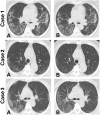Severe COVID-19: A Review of Recent Progress With a Look Toward the Future
- PMID: 32574292
- PMCID: PMC7237759
- DOI: 10.3389/fpubh.2020.00189
Severe COVID-19: A Review of Recent Progress With a Look Toward the Future
Abstract
The novel coronavirus disease 2019 (COVID-19) is an acute infectious disease caused by infection with severe acute respiratory syndrome coronavirus 2 (SARS-CoV-2). Currently, the World Health Organization has confirmed that COVID-19 is a global infectious disease pandemic. This is the third acute infectious disease caused by coronavirus infection in this century, after sudden acute respirator syndrome and Middle East respiratory syndrome. The damage mechanism of SARS-CoV-2 is still unclear. It is possible that protein S binds to angiotensin-converting enzyme 2 receptors and invades alveolar epithelial cells, causing direct toxic effects and an excessive immune response. This stimulates a systemic inflammatory response, thus forming a cytokine storm, which leads to lung tissue injury. In severe cases, the disease can lead to acute respiratory distress syndrome, septic shock, metabolic acidosis, coagulation dysfunction, and multiple organ dysfunction syndromes. Patients with severe COVID-19 have a relatively high mortality rate. Currently, there are no specific antiviral drugs for the treatment of COVID-19. Most patients need to be admitted to the intensive care unit for intensive monitoring and supportive organ function treatments. This article reviews the epidemiology, pathogenesis, clinical manifestations, diagnosis, and treatment methods of severe COVID-19 and puts forward some tentative ideas, aiming to provide some guidance for the diagnosis and treatment of severe COVID-19.
Keywords: COVID-19; diagnosis; epidemiology; pathogenesis; treatment.
Copyright © 2020 Xie, Ma, Tang and Liu.
Figures

References
-
- Gorbalenya AE, Baker SC, Baric RS, de Groot RJ, Drosten C, Gulyaeva AA, et al. (2020). Severe acute respiratory syndrome-related coronavirus: the species and its viruses - a statement of the Coronavirus Study Group. bioRxiv. 10.1101/2020.02.07.937862 - DOI
-
- World Health Organization (2020). Available online at: https://www.who.int/emergencies/diseases/novel-coronavirus-2019/situatio... (accessed Febraury 10, 2020).
-
- JHU COVID-19 Resource Center (2020). Available online at: https://coronavirus.jhu.edu/map.html (accessed April 25, 2020).
Publication types
MeSH terms
Substances
LinkOut - more resources
Full Text Sources
Medical
Miscellaneous

